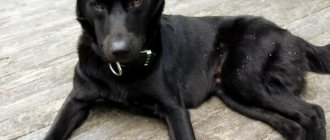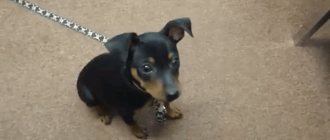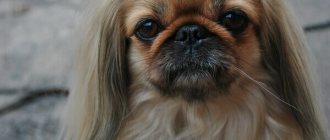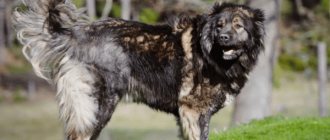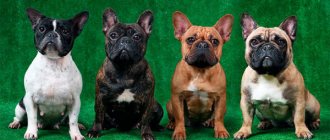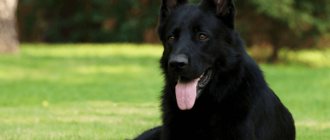It's not often you see a blue Doberman, even just on the street.
And meeting such a dog at an exhibition is completely unthinkable.
After all, despite the fact that the blue and tan color of these majestic and slender animals looks very impressive, it has always been quite rare.
And currently only American kennels are engaged in breeding such dogs.
Why is the blue Doberman considered such a rarity and what features make it unique?
Origin story and what it looks like in the photo
When the founder of the breed, Karl Friedrich Lewis Doberman, set out to create the perfect police dog that could also be a bodyguard dog, he used many other breeds in breeding animals, including Great Danes and, presumably, Weimaraners.
For these dogs, blue color is typical and, as researchers believe, it was thanks to the blood of Great Danes or Weimar pointers that the first steel-gray Dobermanns with rusty-red tan marks appeared.
In 1901, the blue color of the Doberman Pinschers was recognized as standard along with black and brown.
However, after genetic research carried out at the end of the 20th century, it was found that the gene for blue color in Dobermans is associated with some hereditary diseases.
The risk of possible health problems was the reason that the blue color was excluded from the FCI standard in 1994.
Colors
They come in four types:
- black,
- dark brown,
- blue (diluted black),
- isabella (diluted brown).
In any variant, there is a clearly visible tan of red or reddish-red color. It is located symmetrically on the throat, above the eyelids, in the ears, around the mouth, on the cheekbones, chest, under the tail, in the groin and on the limbs.
The first breed standard, established in 1899, recognized only one color - black and tan. In 1901, brown and blue colors were recognized as acceptable. Isabella suit appeared only in 1969.
The current FCI standard includes only two acceptable variants: brown and black and tan. Blue and Isabella colors were excluded due to associated skin and coat problems, as well as reduced immunity.
Disadvantages: too light, blurry or, conversely, darkened tan, large dark spots on the paws, excessively darkened mask.
Disqualifying faults: any white spots. Blue and Isabella colors are considered a breeding defect and such dogs are not allowed for breeding.
In America and the UK, all four options are allowed. In addition, there are white dogs.
Marriage or breed?
Currently, the blue and tan color is considered a breeding defect..
Expert opinion
Kozhevin Semyon Kirillovich
Expert dog handler.
“The blue color of Dobermans looks unusual and impressive. But the weakening of the black pigment to a grayish-blue led to skin diseases becoming common in the breed. Therefore, the blue and tan color was eventually dropped from the official standard. If now there are advertisements for the sale of such puppies, then you need to understand that they were obtained from animals that do not have permission for breeding and that no one can guarantee how healthy they will be.”
Application
This dog needs constant activity.
The Doberman Pinscher will, with equal zeal, accompany its owner on a hunt, save people from rubble, follow a trail, or babysit children.
Dobermans are versatile dogs, they are used for:
— protection of important objects and private territories;
- police and customs services;
— search and rescue operations.
The Doberman Pinscher is well suited for agility , traveling, and playing with children.
But if adults do not plan to raise a dog, then the Doberman Pinscher is not the best choice of a pet for a child.
Dogs are distinguished by: courage, loyalty, attentiveness and fearlessness. They become strongly attached to their owners and protect them in any conditions.
For those who are not ready to devote a lot of time to raising this dog, there is a wonderful alternative - the mini Doberman Pinscher.
This is the name of the miniature pinscher. And although these are completely different breeds, they have a lot in common in appearance.
Advantages and disadvantages
pros:
- Unusual and rare color.
- The Blue Doberman is a loyal and devoted friend who treats all family members equally well.
- These dogs make reliable guards and bodyguards.
- Quite loyal to children.
- Hardy and strong.
- Smart and well trained dog.
- Characterized by courage and moderate malice.
- In normal circumstances he is calm and unperturbed.
Minuses:
- Can be aggressive towards strangers.
- It is highly territorial.
- From the first day the puppy appears in the house, the owner must become an indisputable authority for him.
- May chew or tear things in the house out of boredom.
- Not suitable for year-round outdoor use.
- He remembers grievances for a long time.
- Possible health problems.
The Blue Doberman is very sensitive and excitable, he needs affectionate, but at the same time, strict treatment.
Choosing a nickname
For Dobermans, nicknames should be chosen based on their appearance. These are beautiful, intelligent dogs that are often recruited to serve in the army or police. The Doberman makes a wonderful protector.
The following names are suitable for boys of this breed:
- Emphasizing their strength and physical development: Atlas, Opal, Sunset, Zeus, Pharaoh, Caesar, Hercules, Achilles, Vulcan, Ararat, Sultan, Conan, Gloom, Circassian, Titan, Sherkhan, Elbrus;
- Nicknames that focus on color: Chocolate, Walnut, Ash, Black, Coal, Amber, Yakhont, Truffle;
- Nicknames that echo German names: Albert, Hans, Askold, Karl, Oscar, Jan, Nicholas, Rudolf, Theodor, Schultz, Richard, Jurgen, Max, Michael, Jurgen;
- Nicknames that emphasize the qualities of temperament (after all, how many dogs have so many characters): Rogue, Golden, Friend, Wind, Tango, Cyclone, Miracle, Glorious, Frisky, Fakir, Fire, Mars, Leader, Success, Hurricane, Champion, Romeo, Pilot, Indigo, Storm, Bulldog.
The following nicknames are suitable for girls of the Doberman breed:
- The most aristocratic nicknames that will emphasize the elegant, beautiful and graceful appearance of your dog: Hera, Ariadne, Star, Melisa, Roxy, Liana, Venus, Diva, Bagheera, Aelita, Naomi, Shelly, Stephanie, Yasmin, Aurora, Giselle, Luna, Paula, Camellia.
- To emphasize the temperament of your pet, give the following nicknames: Aida, Love, Verona, Gloria, Clear, Audrey, Oda, Blizzard, Fun, Muse, Night, Sonata, Melody, Doll, Prima, Fairy, Fortune, Charade, Ethiopian, Riddle, Rocket.
Dimensions, weight and other distinctive features
The table below shows standard Doberman sizes:
| Options | Description |
| Height | Males - from 68 to 72 cm, females - from 63 to 68 cm. |
| Weight | Males - from 40 to 45 kg, females - from 32 to 35 kg. |
| Body Format | Square (for girls, slightly stretched is allowed). |
| Body type | Strong dry. |
| Musculature | Well developed. |
| Head | When viewed from above, it is wedge-shaped. The forehead is somewhat flat, the stop is quite pronounced, but small. |
| Muzzle | Elongated, length equal to ½ the length of the head. Moderately wide and deep; in males, as a rule, it is a little more massive than in females. |
| Teeth | White, strong, in full set, consisting of 42 teeth. |
| Bite | Scissor-shaped. |
| Ears | Natural length or docked. |
| Eyes | Not too large, but not small either, oval in shape. Their color is brown of varying lightness and intensity. |
| Neck | Set quite high, moderately muscular and dry. |
| Withers | Well expressed, as a rule, in males it is more developed. |
| Back | Straight, fairly muscular and moderately wide. When displayed, it forms a diagonal line directed downwards towards the croup. |
| Breast | Sufficient depth and width, oval in shape. |
| Stomach | Tight, forming a well-defined bend along the bottom line. |
| Forelegs | Straight and parallel, should not look too thin or too massive. |
| Hind limbs | Well muscled, with wide hips and good angulation of the hocks. |
| Tail | Shortly docked or left at natural length. |
| Wool | Quite tough, smooth, shiny and short. |
| Color | Bluish-steel of varying intensity. It can be either very light or dark, almost the color of wet asphalt. |
A blue Doberman must have a reddish-red tan.
What diseases are they susceptible to?
Like other Dobermans, blue and tan dogs may be predisposed to the following diseases:
- Cardiomyopathy.
- Dysplasia.
- Hypothyroidism.
- Allergies, including food allergies.
- Dermatitis.
- Gastric volvulus.
- Weakened immunity compared to black and brown color varieties of the breed.
NOTE!
Blue Dobermans are susceptible to skin diseases, especially often they have color mutational alopecia, which is expressed in the gradual baldness of certain areas of the body.
This disease appears between the ages of six months and three years, so it is simply impossible to predict whether a puppy will have it or not..
Due to the fact that this type of baldness associated with a weakened gene is especially common in dogs of this breed and color, it even received the unofficial name “Blue Doberman Syndrome.”
White
As already mentioned, white Dobermans are not completely albinos. They have blue eyes and a light cream colored coat with a bronze tint.
Unfortunately, these dogs are in poor health and have the same problems as real albinos. Photophobia forces them to often close their eyes, which makes it difficult to move in space.
There are also problems with teeth: they are too small and fall out quickly. Inbreeding has not been in vain for the nervous system; such animals are characterized by:
- cowardice,
- timidity,
- unpredictability of behavior,
- constant nervousness.
These dogs cannot be used for service or even simply for security purposes and perform a purely decorative function. They do not participate in breeding the breed, are not allowed to exhibitions, are not recognized by any serious cynological organization and are bred exclusively by a small number of amateurs.
Despite its spectacular appearance, this color option has not become widespread, since many negative factors are associated with it, including a short life expectancy.
Does color change with age?
The blue and tan color of Dobermans never changes too much and does not change colors.
It may become a little darker or a little lighter with age, and a more pronounced bluish or silvery sheen may appear..
Sometimes the intensity or shade of the tan may also change.
Red
This color can be described as reddish brown. It comes in different intensities. From light brownish coat with a red sheen to black and burgundy main color background. With this color, Dobermans have tan marks located in the places provided for by the standard.
Red color with tan is considered a variant of the standard brown. Such dogs are allowed to exhibit and participate in breeding.
They are distinguished from ordinary dark brown Dobermans only by a more or less pronounced reddish tint of their coat.
Basic rules of care
The Blue Doberman requires minimal grooming. He needs to be brushed once a week and his ears and eyes cleaned as needed. You should not bathe your dog often, and given the tendency of blue Dobermans to allergies, it is better to do without washing at all.
The nails of a pet of this breed will not have to be cut very often, since if the dog walks on the asphalt quite a lot, they will grind down perfectly on their own..
If the blue Doberman needs to shorten its claws, then this should be done with a nail clipper purchased in advance from a veterinary pharmacy.
It is necessary to vaccinate your pet on time, as well as treat it against external and internal parasites..
You also need to regularly examine the dog’s coat and skin in order to notice the first signs of possible allergies or alopecia in time.
If any are noticed, then it is necessary to show the pet to a veterinarian as soon as possible.
Character
Good upbringing and training can turn him into a self-sufficient, confident, brave, unflappable pet. Doberman puppies already have character and keen intelligence.
However, genetically deformed changes in the psyche cannot be corrected. Therefore, choosing a puppy should be done carefully and without haste.
One person must train the dog. A well-trained pet will follow the commands of not only the owner, but even the child. If you give free rein to the dog, it will be a big disaster for you and those around you.The Doberman sees in its owner a leader and leader, a person with character. This breed is suitable only for strong, strong-willed and determined people.
- Newfoundland - history of the breed, education, care + 73 photos
Chihuahua - history of the breed, description, temperament, attitude towards people and animals, care + 92 photos
Brussels Griffon - history, modern appearance, standards, character and content + 77 photos
Stubbornness, character, integrity, cunning and resourcefulness of the Doberman breed will prevail over your pet.
The learning process is a huge amount of work and responsibility, daily care and concern from the moment you purchase a puppy until the dog is 2-3 years old.
Price range
Since the blue color is considered a breeding choice, these puppies are usually less expensive than the standard black and brown and tan.
The price range for these dogs is quite large: from 5-8 to 25-30 thousand rubles.
At the same time, the cost of a puppy depends not only on its quality, but on the ambitions of the breeder.
How to choose?
It should be remembered that it will not be possible to find a blue Doberman with documents of origin in Russia. This means that the future owner of such a pet will have to either buy a puppy without registration, or go to a foreign kennel to get the dog.
IMPORTANT!
Buying a puppy without documents is always fraught with the risk that the baby may have health problems or an unstable psyche.
If the decision to adopt a dog of this particular color is finally made, then you need to try to find a baby from dogs that have medical certificates.
When choosing a future pet, you need to give preference to a baby who does not show signs of cowardice or, conversely, aggression.
How much do Doberman puppies cost?
Different breeders have different prices, and they also vary depending on the region. On average, you can pay 25,000-35,000 rubles for a puppy with a pedigree. Without documents you can buy a puppy for 5,000 rubles.
Different breeds have their own costs. For example, a mini Doberman can be purchased with documents for 10,000 rubles. Show dogs will be more expensive - about 30,000 rubles.
